Satisfaction-Based Energy Allocation with Energy Constraint Applying Cooperative Game Theory
Abstract
1. Introduction
- Energy satisfaction (ES) is proposed to capture the benefit of energy uses and to model the optimization problem.
- The Shapley Value algorithm is implemented to maximize ES and minimize energy consumption.
- The proposed model also integrated solar-based renewable-energy resources (RESs). Real data from [25] was used for validation.
2. Cooperative Game Theory
2.1. Overview of Game Theory
2.2. Types of Games
2.3. Shapley Value
- Symmetry: The symmetry axiom states that interchangeable players and should receive the same payments: . Two agents are interchangeable if they contribute the same amount to every coalition with the other agents.
- Dummy Axiom: The dummy player contributes to any coalition the same amount that can achieve alone. Thus, for any , if is a dummy player, then .
- Additivity: The additivity axiom states that for any two coalitional game problems, defined by and , we have for any player that = + , where the game is defined by for every coalition .
- Efficiency: The efficiency axioms states that the entire payoff is divided among the players, so , where is the Shapley Value of player .
3. Satisfaction Model
3.1. Satisfaction Concept
3.2. User Input Satisfaction
- Satisfaction among devices can be compared at two levels: time-based, satisfaction , and device-based satisfaction Δ, as defined by Ogunjuyigbe [8]. The former implies that if there is a device no. 1, then the satisfaction it is providing at time , , can be compared with the satisfaction the same device is providing at different time , ). For the latter, if the two devices need to be used at the same time, then there is a satisfaction derived from using device no. 1 ), which can be compared with the satisfaction derived from using device no. 2 at that hour.
- Time-based satisfaction has an integer numerical value from zero (0) to six (6), where six (6) means completely satisfied, three (3) means neutral, and small satisfaction values, such zero (0), one (1) and two (2) will denote dissatisfaction.
- Three (3) levels of time-based satisfaction are identified according with these seven (7) scores, see Table 1.
3.3. Power Satisfaction
3.4. Equation of Power Satisfaction
3.5. Energy Satisfaction
4. Problem Formulation
4.1. Electric Energy Function
4.2. Optimization Problem
4.3. Constraint
4.4. Cooperative Game Model Implementation
- Players:
- Actions:
- Payoffs:
- Value of coalition:
5. Experimental Results and Discussion
5.1. Case Study: House with Photovolatic System (PV) and Utility or House with PV, Batteries and Utility
5.2. Data Characterization for the Algorithm Calibration
5.2.1. Household’s Load
5.2.2. House Head’s Satisfaction
5.2.3. Results
5.3. Data Characterization for the Algorithm Testing.
5.3.1. House Head’s Satisfaction
5.3.2. Results
6. Conclusions
Author Contributions
Funding
Data Availability Statement
Conflicts of Interest
References
- Access to Energy|Sustainable Energy for All. Available online: https://www.seforall.org/goal-7-targets/access (accessed on 24 February 2021).
- Wu, Q.; Ren, H.; Gao, W.; Ren, J. Benefit allocation for distributed energy network participants applying game theory based solutions. Energy 2017, 119, 384–391. [Google Scholar] [CrossRef]
- Tang, R.; Wang, S.; Wang, H. Optimal power demand management for cluster-level commercial buildings using the game theoretic method. Energy Procedia 2019, 159, 186–191. [Google Scholar] [CrossRef]
- Lokeshgupta, B.; Sivasubramani, S. Cooperative game theory approach for multi-objective home energy management with renewable energy integration. IET Smart Grid 2019, 2, 34–41. [Google Scholar] [CrossRef]
- Yang, P.; Tang, G.; Nehorai, A. A game-theoretic approach for optimal time-of-use electricity pricing. IEEE Trans. Power Syst. 2012, 28, 884–892. [Google Scholar] [CrossRef]
- Marzband, M.; Ardeshiri, R.R.; Moafi, M.; Uppal, H. Distributed generation for economic benefit maximization through coalition formation–based game theory concept. Int. Trans. Electr. Energy Syst. 2017, 27, e2313. [Google Scholar] [CrossRef]
- Shahzad, S.; Brennan, J.; Theodossopoulos, D.; Hughes, B.; Calautit, J.K. Energy and comfort in contemporary open plan and traditional personal offices. Appl. Energy 2017, 185, 1542–1555. [Google Scholar] [CrossRef]
- Ogunjuyigbe, A.S.O.; Ayodele, T.R.; Akinola, O.A. User satisfaction-induced demand side load management in residential buildings with user budget constraint. Appl. Energy 2017, 187, 352–366. [Google Scholar] [CrossRef]
- Yoon, S.G.; Choi, Y.J.; Park, J.K.; Bahk, S. Stackelberg-Game-Based Demand Response for At-Home Electric Vehicle Charging. IEEE Trans. Veh. Technol. 2016, 65, 4172–4184. [Google Scholar] [CrossRef]
- Yu, M.; Hong, S.H. A Real-Time Demand-Response Algorithm for Smart Grids: A Stackelberg Game Approach. IEEE Trans. Smart Grid 2016, 7, 879–888. [Google Scholar] [CrossRef]
- Azimian, B.; Fijani, R.F.; Ghotbi, E.; Wang, X. Stackelberg game approach on modeling of supply demand behavior considering BEV uncertainty. In Proceedings of the 2018 IEEE International Conference on Probabilistic Methods Applied to Power Systems (PMAPS), Boise, ID, USA, 24–28 June 2018. [Google Scholar] [CrossRef]
- Jia, L.; Tong, L. Dynamic Pricing and Distributed Energy Management for Demand Response. IEEE Trans. Smart Grid 2016, 7, 1128–1136. [Google Scholar] [CrossRef]
- Ma, L.; Liu, N.; Wang, L.; Zhang, J.; Lei, J.; Zeng, Z.; Wang, C.; Cheng, M. Multi-party energy management for smart building cluster with PV systems using automatic demand response. Energy Build. 2016, 121, 11–21. [Google Scholar] [CrossRef]
- Agyeman, K.; Han, S.; Han, S. Real-Time Recognition Non-Intrusive Electrical Appliance Monitoring Algorithm for a Residential Building Energy Management System. Energies 2015, 8, 9029–9048. [Google Scholar] [CrossRef]
- Pal, S.; Thakur, S.; Kumar, R.; Panigrahi, B.K. A strategical game theoretic based demand response model for residential consumers in a fair environment. Int. J. Electr. Power Energy Syst. 2018, 97, 201–210. [Google Scholar] [CrossRef]
- Wang, Z.; Paranjape, R. Optimal Residential Demand Response for Multiple Heterogeneous Homes with Real-Time Price Prediction in a Multiagent Framework. IEEE Trans. Smart Grid 2017, 8, 1173–1184. [Google Scholar] [CrossRef]
- Buchanan, K.; Banks, N.; Preston, I.; Russo, R. Corrigendum to The British public’s perception of the UK smart metering initiative: Threats and opportunities. Energy Policy 2016, 91, 87–97. [Google Scholar] [CrossRef]
- Aked, J.; Cordon, C.; Marks, N. Five Ways to Wellbeing: A report Oresented to The Foresight Project on Communicating the Evidence Base for Improving People’s Well-Being|Repository for Arts and Health Resources. Available online: https://www.artshealthresources.org.uk/docs/five-ways-to-wellbeing-a-report-presented-to-the-foresight-project-on-communicating-the-evidence-base-for-improving-peoples-well-being/ (accessed on 5 February 2021).
- Ortiz, S.; Ndoye, M.; Castro-Sitiriche, M. Toward an Energy Threshold Hypothesis Model for Social Benefit and Household Energy Usage. In Proceedings of the International Conference on Appropriate Technology 2020, Pretoria, South Africa, 23–27 November 2020; pp. 346–355. [Google Scholar]
- Sarker, E.; Halder, P.; Seyedmahmoudian, M.; Jamei, E.; Horan, B.; Mekhilef, S.; Stojcevski, A. Progress on the demand side management in smart grid and optimization approaches. Int. J. Energy Res. 2021, 45, 36–64. [Google Scholar] [CrossRef]
- Tzanetos, A.; Dounias, G. Nature inspired optimization algorithms or simply variations of metaheuristics? Artif. Intell. Rev. 2020. [Google Scholar] [CrossRef]
- Robert, C. Editorial: Responsible well-being—A personal agenda for development. World Dev. 1997, 25, 1743–1754. Available online: https://ideas.repec.org/a/eee/wdevel/v25y1997i11p1743-1754.html (accessed on 5 February 2021).
- Castro-Sitiriche, M.J.; Ndoye, M. On the Links between Sustainable Wellbeing and Electric Energy Consumption. Afr. J. Sci. Technol. Innov. Dev. 2013, 5, 327–335. [Google Scholar] [CrossRef]
- Max-Neef, M. Economic growth and quality of life: A threshold hypothesis. Ecol. Econ. 1995, 15, 115–118. [Google Scholar] [CrossRef]
- NREL. Solar Resource Data. Jurutungo Community, Puerto Rico. Available online: https://pvwatts.nrel.gov/pvwatts.php (accessed on 11 November 2020).
- Osborne, M.J.; Rubinstein, A. A Course in Game Theory; The MIT Press: Cambridge, MA, USA, 2011. [Google Scholar]
- O’Brien, G.; El Gamal, A.; Rajagopal, R. Shapley Value Estimation for Compensation of Participants in Demand Response Programs. IEEE Trans. Smart Grid 2015, 6, 2837–2844. [Google Scholar] [CrossRef]
- Jackson, M.O.; Leyton-Brown, K.; Yoav, S. Game Theory Online. Available online: http://game-theory-class.org/game-theory-I.html (accessed on 24 February 2021).
- Arif, M.A.; Ndoye, M.; Murphy, G.V.; Aganah, K. A cooperative game theory algorithm for distributed reactive power reserve optimization and voltage profile improvement. In Proceedings of the 2017 North American Power Symposium (NAPS), Morgantown, WV, USA, 17–19 September 2017. [Google Scholar] [CrossRef]
- Leyton-Brown, K.; Shoham, Y. Essentials of Game Theory: A Concise Multidisciplinary Introduction. Synth. Lect. Artif. Intell. Mach. Learn. 2008, 2, 1–88. [Google Scholar] [CrossRef]
- Kolter, J.Z.; Batra, S.; Ng, A.Y. Energy disaggregation via discriminative sparse coding. In Proceedings of the Advances in Neural Information Processing Systems 23: 24th Annual Conference on Neural Information Processing Systems 2010, Vancouver, BC, Canada, 6–9 December 2010. [Google Scholar]

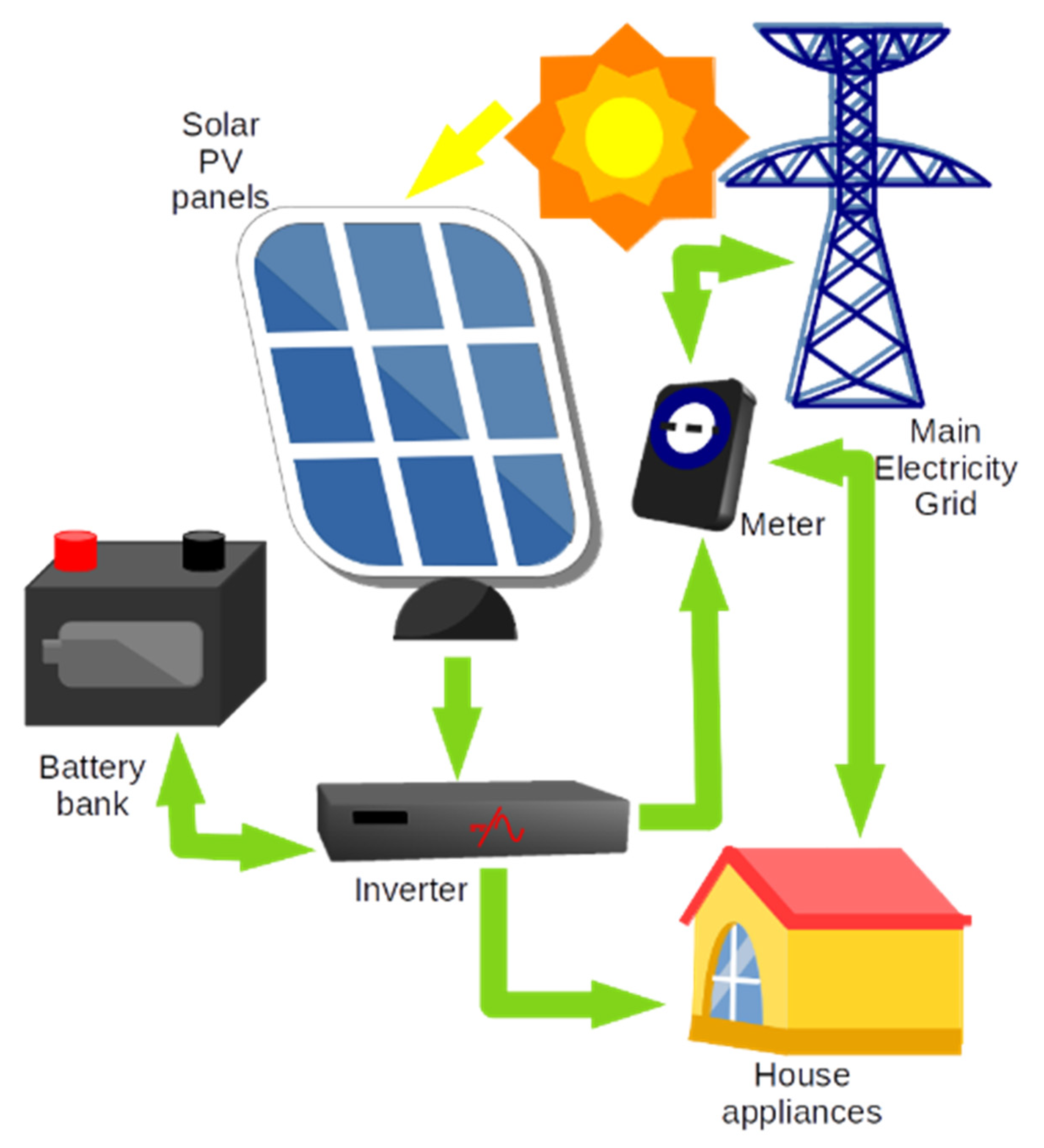
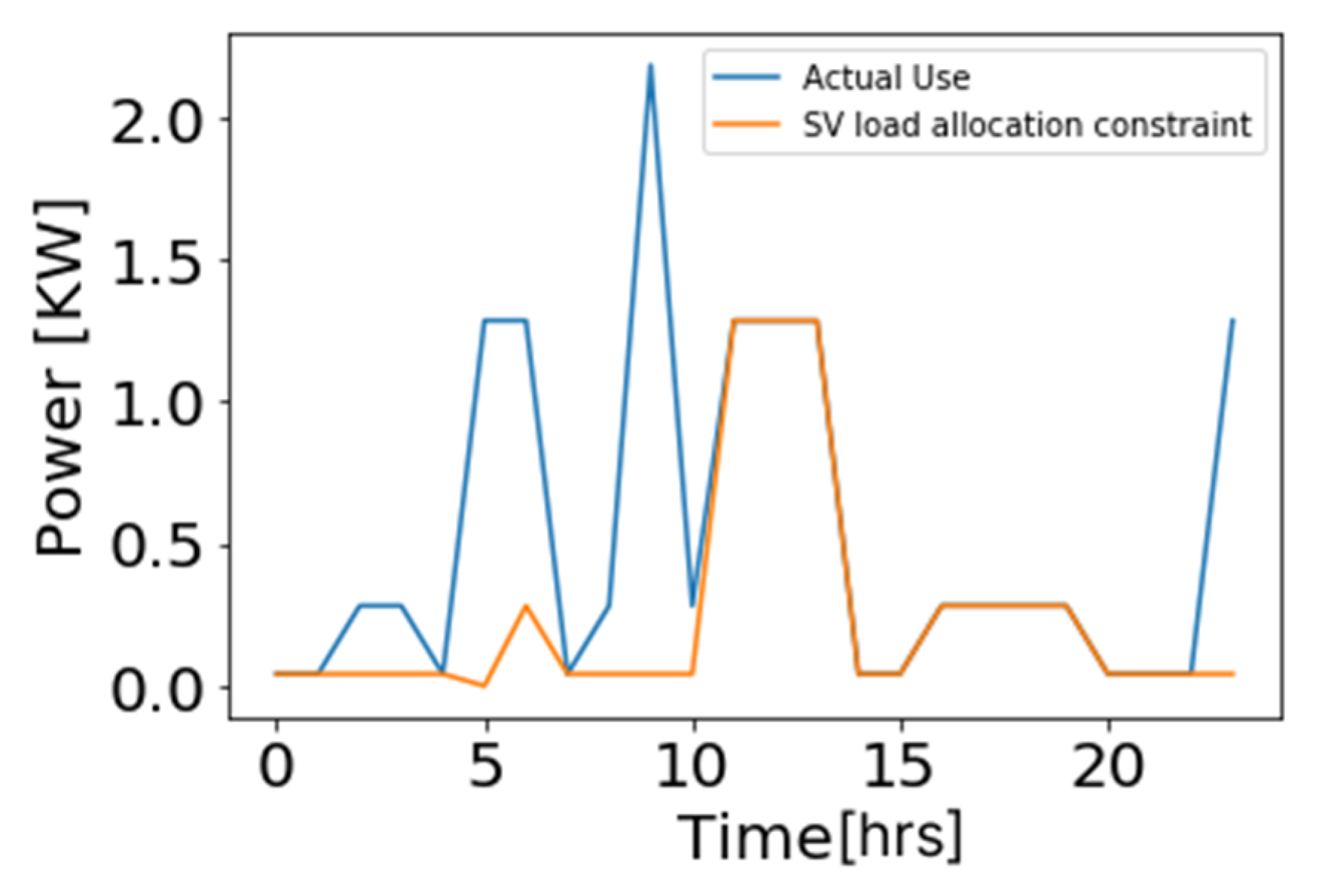
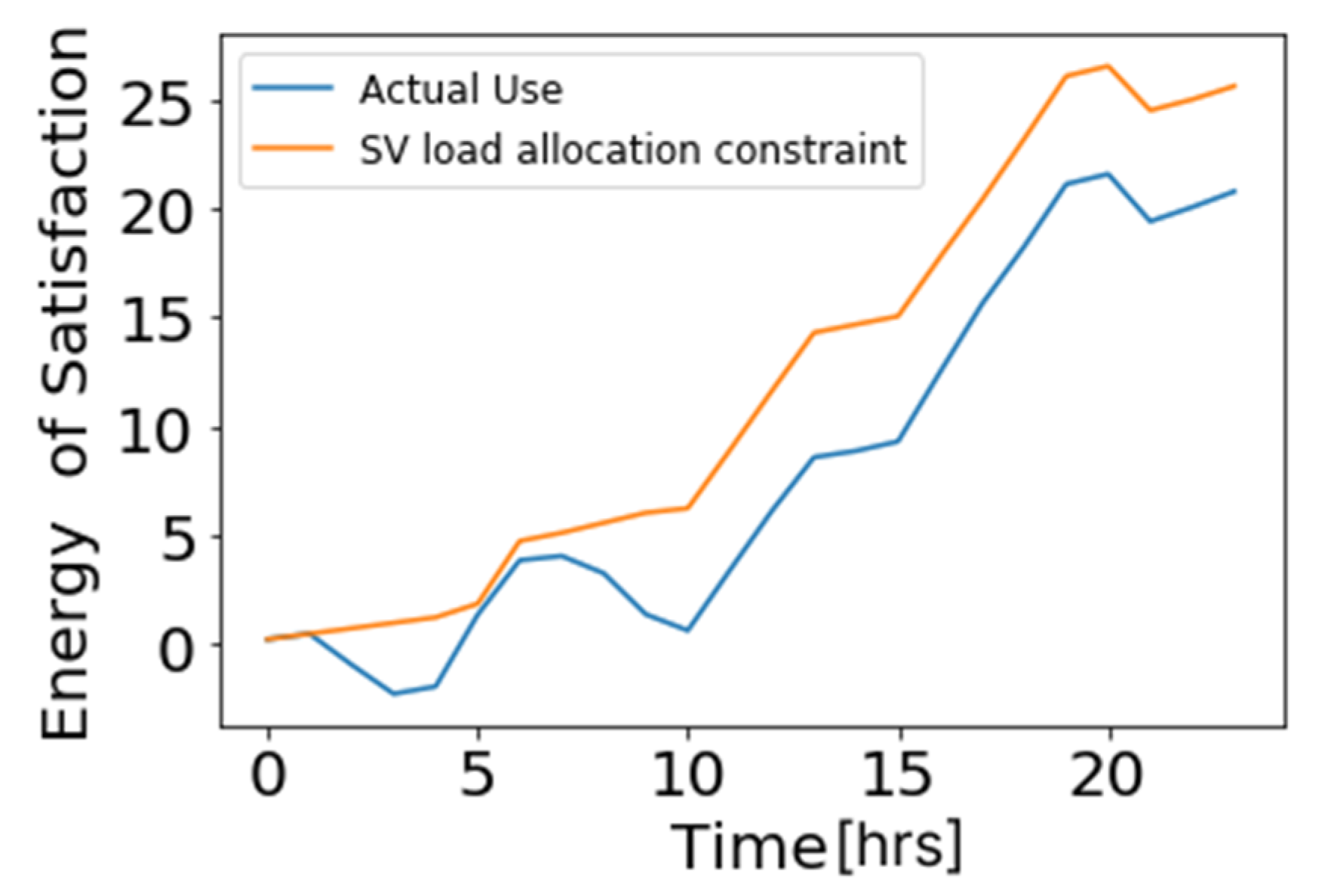
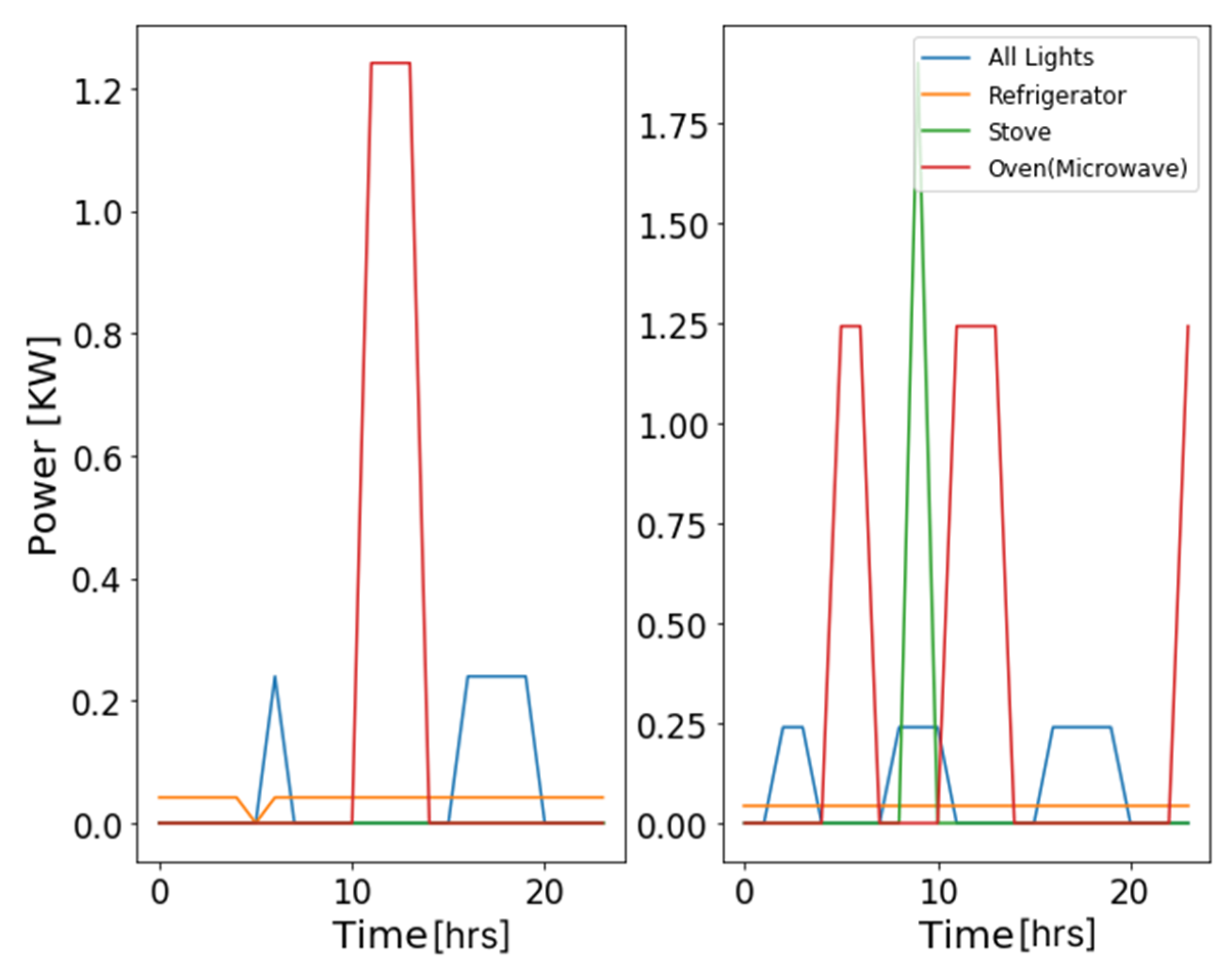
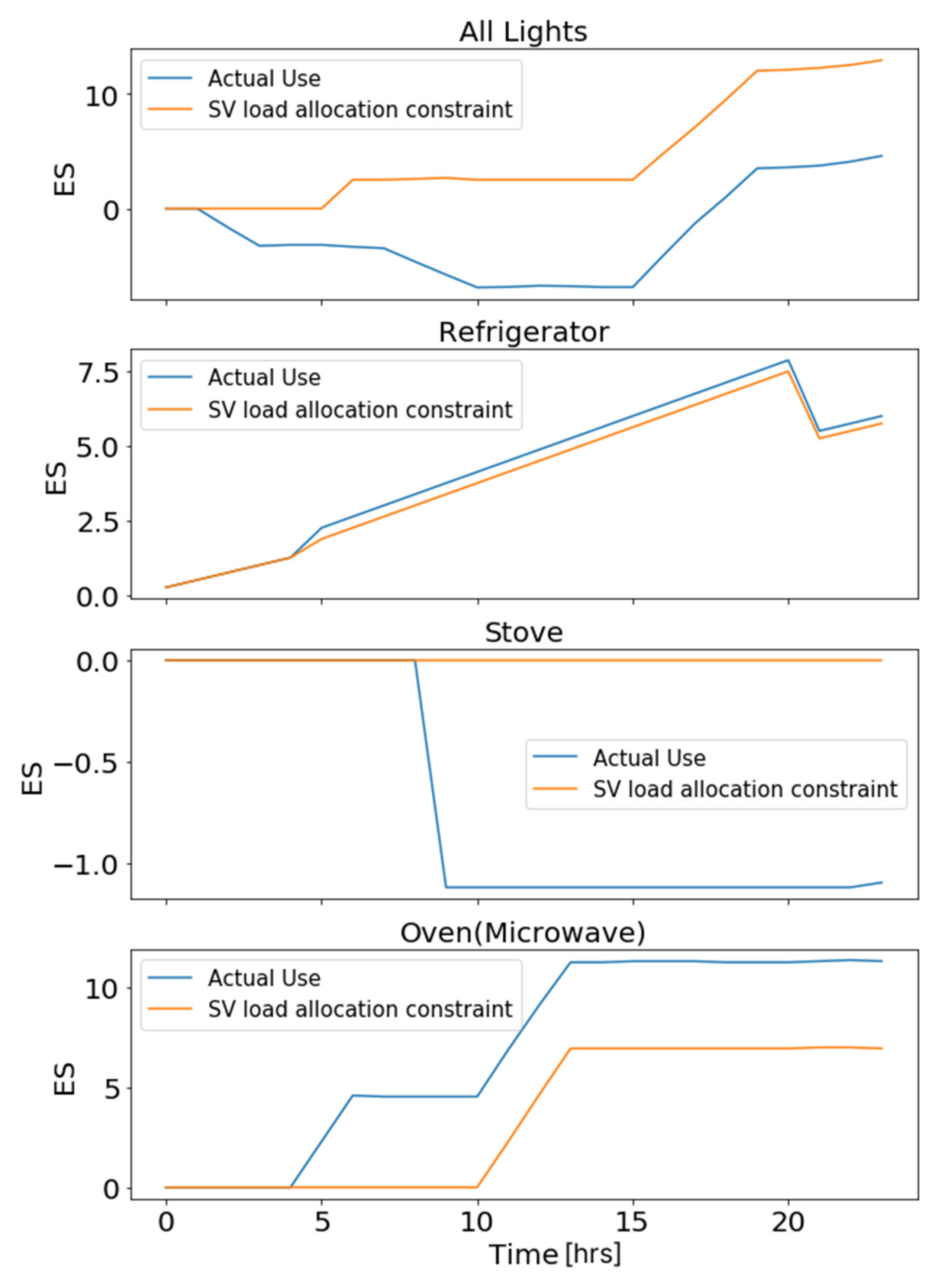
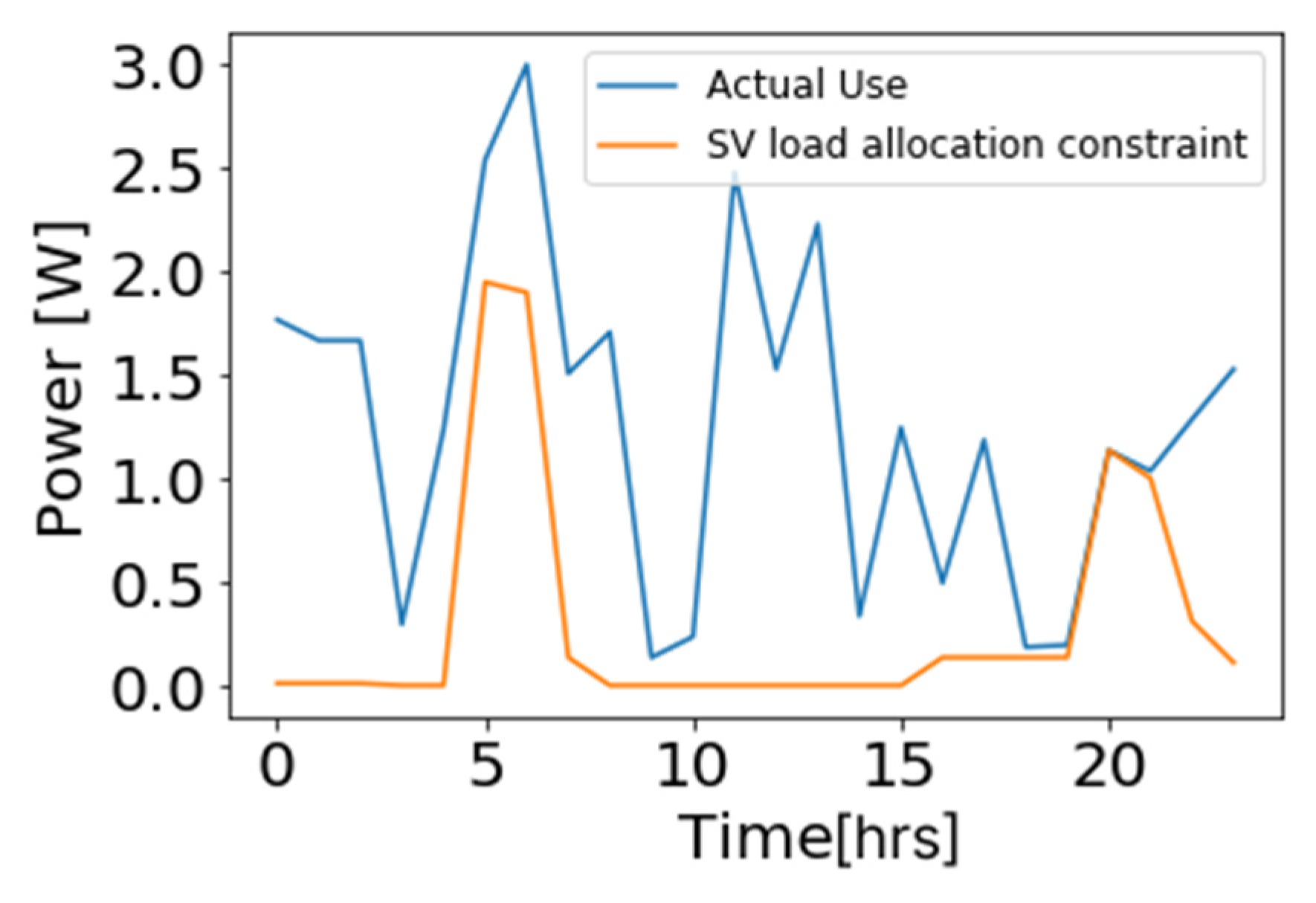
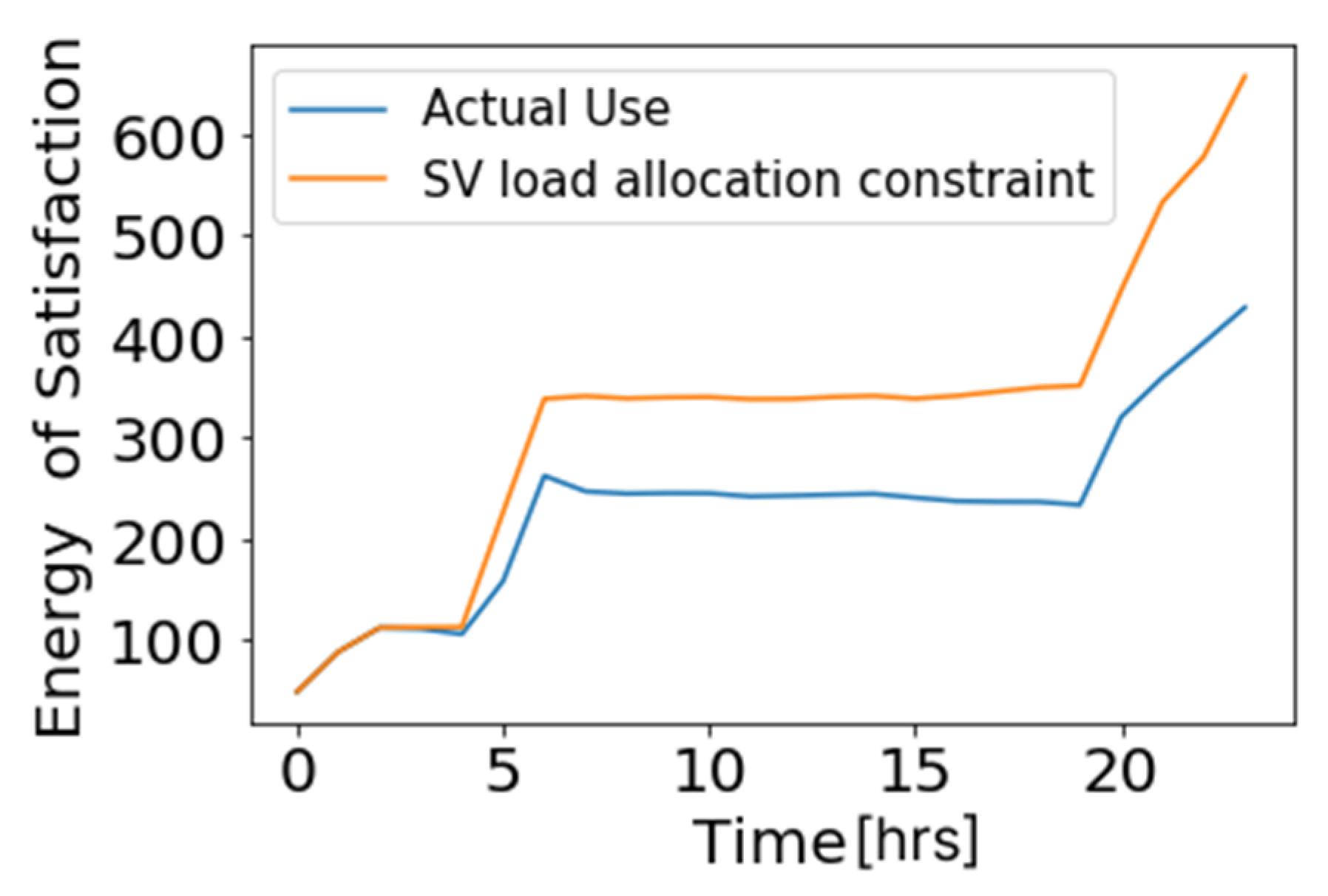
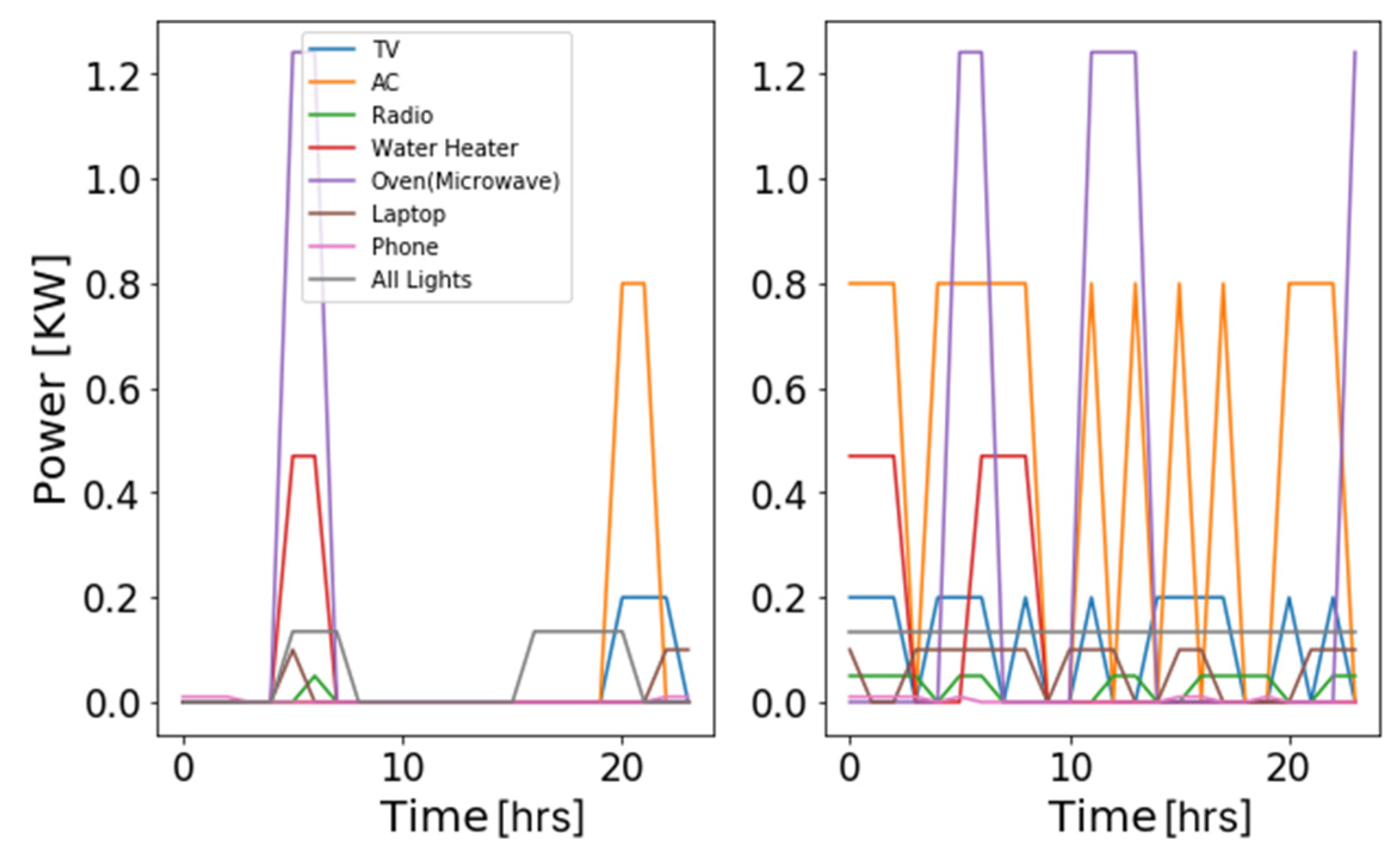
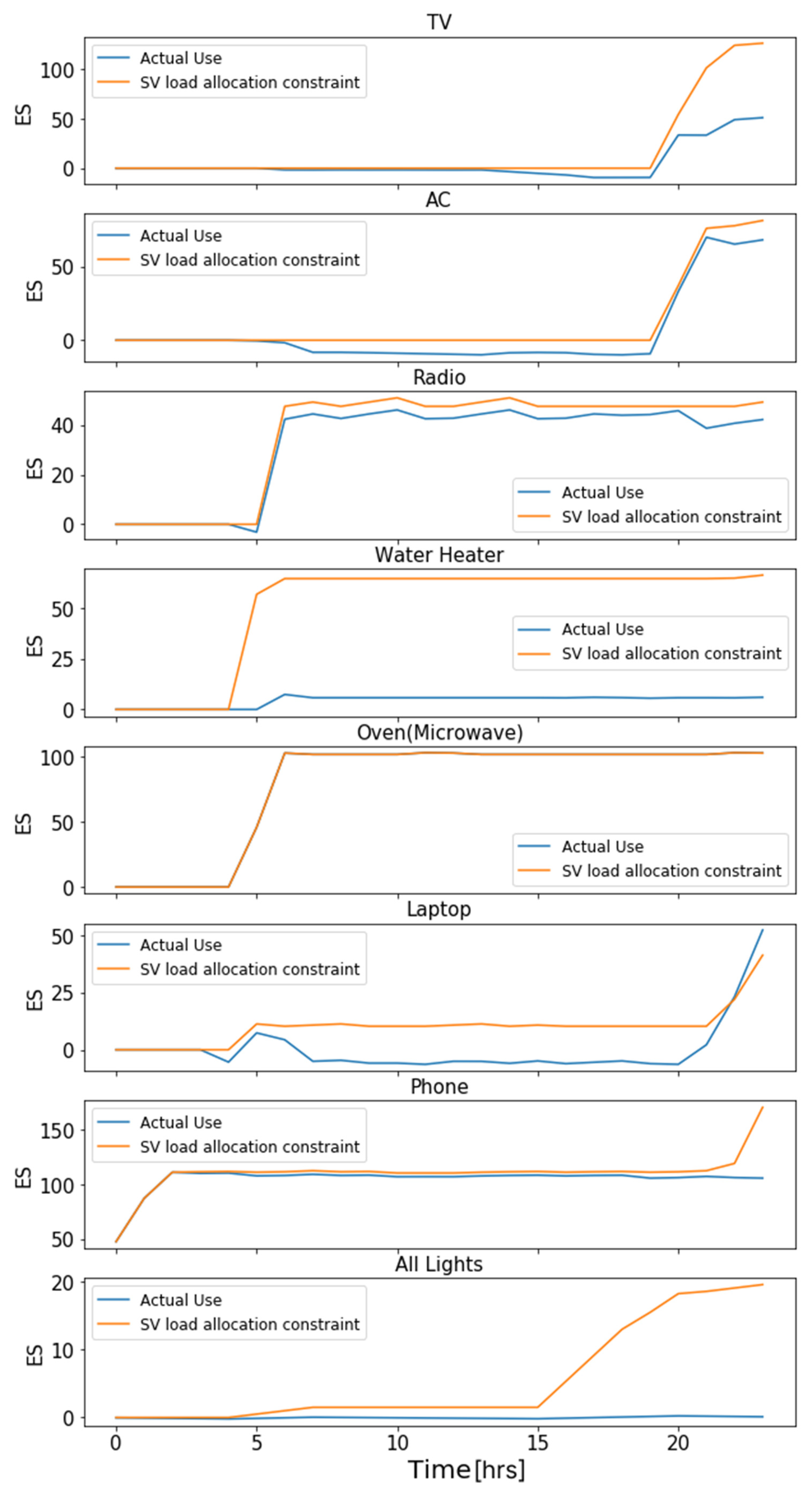
| Level | Respondent’s Answer |
|---|---|
| Satisfied | 4, 5, 6 |
| Neutral | 3 |
| Unsatisfied | 0, 1, 2 |
| Device | Rating (W) | tu | tt |
|---|---|---|---|
| Lightings | 240 | 4 | 8 |
| Refrigerator | 170 | 24 | 24 |
| Stove | 2 | 3 | 9 |
| Microwave (Oven) | 1200 | 1 | 4 |
| S/N | Equipment | Hours | |||||||||||||||||||||||
|---|---|---|---|---|---|---|---|---|---|---|---|---|---|---|---|---|---|---|---|---|---|---|---|---|---|
| 1 | 2 | 3 | 4 | 5 | 6 | 7 | 8 | 9 | 10 | 11 | 12 | 13 | 14 | 15 | 16 | 17 | 18 | 19 | 20 | 21 | 22 | 23 | 24 | ||
| 1 | Lightings | −3 | −3 | −3 | −3 | −3 | 6 | 6 | 6 | −2 | −2 | −2 | −2 | −2 | −2 | −2 | −2 | 6 | 6 | 6 | 6 | 6 | −3 | −3 | −3 |
| 2 | Refrigerator | 4 | 4 | 4 | 4 | 4 | 6 | 6 | 6 | 6 | 6 | 6 | 6 | 6 | 6 | 6 | 6 | 6 | 6 | 6 | 6 | 6 | 4 | 4 | 4 |
| 3 | Stove | −2 | −2 | −2 | −2 | −2 | 6 | 6 | 6 | −2 | −2 | −2 | 5 | 6 | 6 | 5 | −2 | −2 | −2 | −2 | 6 | 6 | −2 | −2 | −2 |
| 4 | Microwave | 4 | 4 | 0 | 0 | 0 | 6 | 6 | 6 | 6 | 0 | 0 | 6 | 6 | 6 | 0 | 0 | 0 | 0 | 6 | 6 | 6 | 0 | 0 | 0 |
| S/N | Equipment | Hours | |||||||||||||||||||||||
|---|---|---|---|---|---|---|---|---|---|---|---|---|---|---|---|---|---|---|---|---|---|---|---|---|---|
| 1 | 2 | 3 | 4 | 5 | 6 | 7 | 8 | 9 | 10 | 11 | 12 | 13 | 14 | 15 | 16 | 17 | 18 | 19 | 20 | 21 | 22 | 23 | 24 | ||
| 1 | Lightings | 4 | 4 | 4 | 4 | 4 | 4 | 4 | 4 | 4 | 4 | 4 | 4 | 4 | 4 | 4 | 4 | 4 | 4 | 4 | 4 | 4 | 4 | 4 | 4 |
| 2 | Refrigerator | 1 | 1 | 1 | 1 | 1 | 1 | 1 | 1 | 1 | 1 | 1 | 1 | 1 | 1 | 1 | 1 | 1 | 1 | 1 | 1 | 1 | 1 | 1 | 1 |
| 3 | Stove | −2 | −2 | −2 | −2 | −2 | −2 | −2 | −2 | −2 | −2 | −2 | −2 | −2 | −2 | −2 | −2 | −2 | −2 | −2 | −2 | −2 | −2 | −2 | −2 |
| 4 | Microwave | 4 | 4 | 4 | 4 | 4 | 4 | 4 | 4 | 4 | 4 | 4 | 4 | 4 | 4 | 4 | 4 | 4 | 4 | 4 | 4 | 4 | 4 | 4 | 4 |
| Device | Rating (W) | tu | tt |
|---|---|---|---|
| Lightings | 135 | 4 | 8 |
| Microwave (Oven) | 1200 | 1 | 4 |
| TV | 200 | 2 | 4 |
| AC | 800 | 6 | 8 |
| Radio | 50 | 5 | 12 |
| Water Heater | 2000 | 1 | 2 |
| Laptop | 100 | 8 | 12 |
| Phone | 10 | 1 | 3 |
| S/N | Equipment | Hours | |||||||||||||||||||||||
|---|---|---|---|---|---|---|---|---|---|---|---|---|---|---|---|---|---|---|---|---|---|---|---|---|---|
| 1 | 2 | 3 | 4 | 5 | 6 | 7 | 8 | 9 | 10 | 11 | 12 | 13 | 14 | 15 | 16 | 17 | 18 | 19 | 20 | 21 | 22 | 23 | 24 | ||
| 1 | TV | 0.0 | 0.0 | 0.0 | 0.0 | 0.0 | 0.0 | −2.4 | −2.4 | 0.0 | 0.0 | 0.0 | 0.0 | 0.0 | 0.0 | −2.4 | −2.4 | −2.4 | −1.8 | 4.4 | 6.0 | 6.0 | 5.2 | 4.4 | −0.6 |
| 2 | Lighting | 0.0 | 0.0 | 0.0 | 0.0 | 0.0 | 4.8 | 4.0 | −0.6 | −2.4 | 0.0 | 0.0 | 0.0 | 0.0 | 0.0 | 0.0 | 0.0 | −1.2 | 4.0 | 4.4 | 6.0 | 6.0 | 5.2 | 4.4 | −1.2 |
| 3 | AC | 0.0 | 0.0 | 0.0 | 0.0 | −2.4 | −0.6 | −1.8 | −2.4 | 0.0 | 0.0 | 0.0 | 0.0 | 0.0 | 0.0 | 0.0 | 0.0 | −2.4 | −1.2 | −1.2 | 4.4 | 6.0 | 6.0 | −1.8 | −2.4 |
| 4 | Radio | 0.0 | 0.0 | 0.0 | 0.0 | −2.4 | −1.8 | 6.0 | −1.8 | −1.8 | −2.4 | 0.0 | 0.0 | 0.0 | 0.0 | 0.0 | 0.0 | 0.0 | 0.0 | −2.4 | −1.8 | −1.8 | 0.0 | 0.0 | 0.0 |
| 5 | Water Heater | 0.0 | 0.0 | 0.0 | −2.4 | −1.2 | 6.0 | 4.0 | −1.8 | −2.4 | 0.0 | 0.0 | 0.0 | 0.0 | 0.0 | 0.0 | 0.0 | 0.0 | 0.0 | 0.0 | 0.0 | 0.0 | 0.0 | 0.0 | 0.0 |
| 6 | Lighting | 0.0 | 0.0 | 0.0 | 0.0 | −1.2 | 6.0 | −1.2 | −1.8 | −2.4 | 0.0 | 0.0 | 0.0 | 0.0 | 0.0 | 0.0 | 0.0 | 0.0 | −1.8 | −2.4 | −1.8 | 6.0 | 4.0 | −1.2 | −1.8 |
| 7 | Microwave Oven | 0.0 | 0.0 | 0.0 | 0.0 | −2.4 | 6.0 | 6.0 | −2.4 | 0.0 | 0.0 | 0.0 | 0.0 | 0.0 | 0.0 | 0.0 | 0.0 | −2.4 | −2.4 | 4.8 | 6.0 | −1.2 | −2.4 | 0.0 | 0.0 |
| 8 | Lighting | 0.0 | 0.0 | 0.0 | 0.0 | −1.2 | 6.0 | 4.0 | −1.2 | −2.4 | 0.0 | 0.0 | 0.0 | 0.0 | 0.0 | 0.0 | 0.0 | 0.0 | −2.4 | 4.8 | 6.0 | −0.6 | −1.8 | −2.4 | 0.0 |
| 9 | Lighting | 6.0 | 6.0 | 5.6 | 5.2 | 4.8 | 4.4 | −1.2 | −2.4 | 0.0 | 0.0 | 0.0 | 0.0 | 0.0 | 0.0 | 0.0 | 0.0 | 0.0 | −2.4 | −1.8 | 4.0 | 4.8 | 5.2 | 5.6 | 6.0 |
| 10 | Lighting | 0.0 | 0.0 | 0.0 | 0.0 | −1.8 | 6.0 | 4.8 | −1.2 | −2.4 | 0.0 | 0.0 | 0.0 | 0.0 | 0.0 | 0.0 | 0.0 | 0.0 | −2.4 | −1.8 | −0.6 | 4.0 | 4.8 | 6.0 | −0.6 |
| 11 | Laptop | 0.0 | 0.0 | 0.0 | 0.0 | −2.4 | 4.0 | −1.2 | −2.4 | −2.4 | 0.0 | 0.0 | 0.0 | 0.0 | 0.0 | 0.0 | 0.0 | 0.0 | 0.0 | −2.4 | −2.4 | −1.2 | 4.0 | 6.0 | 5.2 |
| 12 | Phone | 6.0 | 4.8 | 4.4 | −0.6 | −1.2 | −1.2 | −1.8 | −2.4 | 0.0 | 0.0 | 0.0 | 0.0 | 0.0 | 0.0 | 0.0 | 0.0 | 0.0 | 0.0 | −2.4 | −2.4 | −2.4 | −1.2 | 4.0 | 6.0 |
| S/N | Equipment | Hours | |||||||||||||||||||||||
|---|---|---|---|---|---|---|---|---|---|---|---|---|---|---|---|---|---|---|---|---|---|---|---|---|---|
| 1 | 2 | 3 | 4 | 5 | 6 | 7 | 8 | 9 | 10 | 11 | 12 | 13 | 14 | 15 | 16 | 17 | 18 | 19 | 20 | 21 | 22 | 23 | 24 | ||
| 1 | TV | 0.0 | 0.0 | 0.0 | 0.0 | 0.0 | 0.0 | −2.4 | −2.4 | 0.0 | 0.0 | 0.0 | 0.0 | 0.0 | 0.0 | −2.4 | −2.4 | −2.4 | −1.8 | 4.4 | 6.0 | 6.0 | 5.2 | 4.4 | −0.6 |
| 2 | Lighting | 0.0 | 0.0 | 0.0 | 0.0 | 0.0 | 4.8 | 4.0 | −0.6 | −2.4 | 0.0 | 0.0 | 0.0 | 0.0 | 0.0 | 0.0 | 0.0 | −1.2 | 4.0 | 4.4 | 6.0 | 6.0 | 5.2 | 4.4 | −1.2 |
| 3 | AC | 0.0 | 0.0 | 0.0 | 0.0 | −2.4 | −0.6 | −1.8 | −2.4 | 0.0 | 0.0 | 0.0 | 0.0 | 0.0 | 0.0 | 0.0 | 0.0 | −2.4 | −1.2 | −1.2 | 4.4 | 6.0 | 6.0 | −1.8 | −2.4 |
| 4 | Radio | 0.0 | 0.0 | 0.0 | 0.0 | −2.4 | −1.8 | 6.0 | −1.8 | −1.8 | −2.4 | 0.0 | 0.0 | 0.0 | 0.0 | 0.0 | 0.0 | 0.0 | 0.0 | −2.4 | −1.8 | −1.8 | 0.0 | 0.0 | 0.0 |
| 5 | Water Heater | 0.0 | 0.0 | 0.0 | −2.4 | −1.2 | 6.0 | 4.0 | −1.8 | −2.4 | 0.0 | 0.0 | 0.0 | 0.0 | 0.0 | 0.0 | 0.0 | 0.0 | 0.0 | 0.0 | 0.0 | 0.0 | 0.0 | 0.0 | 0.0 |
| 6 | Lighting | 0.0 | 0.0 | 0.0 | 0.0 | −1.2 | 6.0 | −1.2 | −1.8 | −2.4 | 0.0 | 0.0 | 0.0 | 0.0 | 0.0 | 0.0 | 0.0 | 0.0 | −1.8 | −2.4 | −1.8 | 6.0 | 4.0 | −1.2 | −1.8 |
| 7 | Microwave Oven | 0.0 | 0.0 | 0.0 | 0.0 | −2.4 | 6.0 | 6.0 | −2.4 | 0.0 | 0.0 | 0.0 | 0.0 | 0.0 | 0.0 | 0.0 | 0.0 | −2.4 | −2.4 | 4.8 | 6.0 | −1.2 | −2.4 | 0.0 | 0.0 |
| 8 | Lighting | 0.0 | 0.0 | 0.0 | 0.0 | −1.2 | 6.0 | 4.0 | −1.2 | −2.4 | 0.0 | 0.0 | 0.0 | 0.0 | 0.0 | 0.0 | 0.0 | 0.0 | −2.4 | 4.8 | 6.0 | −0.6 | −1.8 | −2.4 | 0.0 |
| 9 | Lighting | 6.0 | 6.0 | 5.6 | 5.2 | 4.8 | 4.4 | −1.2 | −2.4 | 0.0 | 0.0 | 0.0 | 0.0 | 0.0 | 0.0 | 0.0 | 0.0 | 0.0 | −2.4 | −1.8 | 4.0 | 4.8 | 5.2 | 5.6 | 6.0 |
| 10 | Lighting | 0.0 | 0.0 | 0.0 | 0.0 | −1.8 | 6.0 | 4.8 | −1.2 | −2.4 | 0.0 | 0.0 | 0.0 | 0.0 | 0.0 | 0.0 | 0.0 | 0.0 | −2.4 | −1.8 | −0.6 | 4.0 | 4.8 | 6.0 | −0.6 |
| 11 | Laptop | 0.0 | 0.0 | 0.0 | 0.0 | −2.4 | 4.0 | −1.2 | −2.4 | −2.4 | 0.0 | 0.0 | 0.0 | 0.0 | 0.0 | 0.0 | 0.0 | 0.0 | 0.0 | −2.4 | −2.4 | −1.2 | 4.0 | 6.0 | 5.2 |
| 12 | Phone | 6.0 | 4.8 | 4.4 | −0.6 | −1.2 | −1.2 | −1.8 | −2.4 | 0.0 | 0.0 | 0.0 | 0.0 | 0.0 | 0.0 | 0.0 | 0.0 | 0.0 | 0.0 | −2.4 | −2.4 | −2.4 | −1.2 | 4.0 | 6.0 |
Publisher’s Note: MDPI stays neutral with regard to jurisdictional claims in published maps and institutional affiliations. |
© 2021 by the authors. Licensee MDPI, Basel, Switzerland. This article is an open access article distributed under the terms and conditions of the Creative Commons Attribution (CC BY) license (http://creativecommons.org/licenses/by/4.0/).
Share and Cite
Ortiz, S.; Ndoye, M.; Castro-Sitiriche, M. Satisfaction-Based Energy Allocation with Energy Constraint Applying Cooperative Game Theory. Energies 2021, 14, 1485. https://doi.org/10.3390/en14051485
Ortiz S, Ndoye M, Castro-Sitiriche M. Satisfaction-Based Energy Allocation with Energy Constraint Applying Cooperative Game Theory. Energies. 2021; 14(5):1485. https://doi.org/10.3390/en14051485
Chicago/Turabian StyleOrtiz, Samira, Mandoye Ndoye, and Marcel Castro-Sitiriche. 2021. "Satisfaction-Based Energy Allocation with Energy Constraint Applying Cooperative Game Theory" Energies 14, no. 5: 1485. https://doi.org/10.3390/en14051485
APA StyleOrtiz, S., Ndoye, M., & Castro-Sitiriche, M. (2021). Satisfaction-Based Energy Allocation with Energy Constraint Applying Cooperative Game Theory. Energies, 14(5), 1485. https://doi.org/10.3390/en14051485





